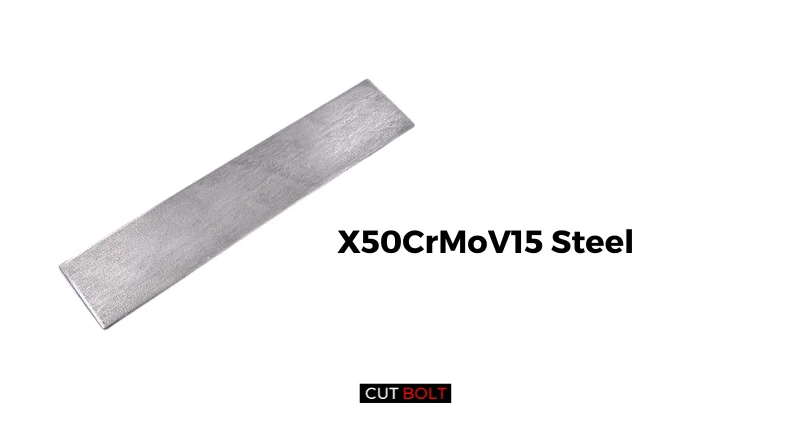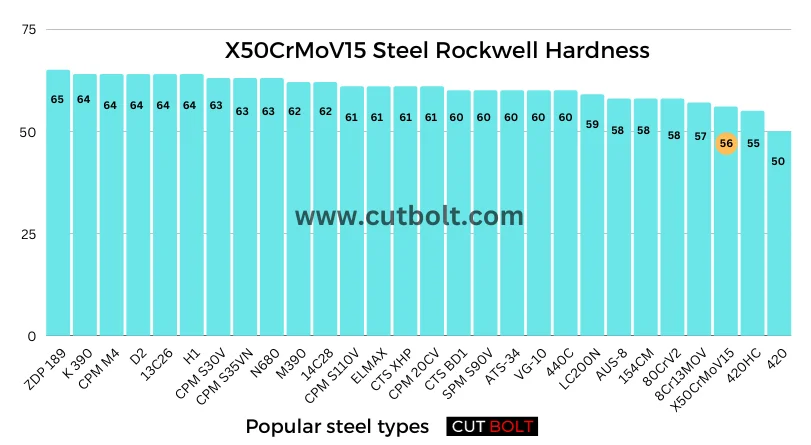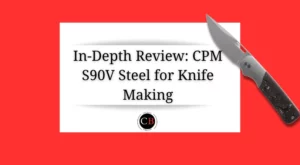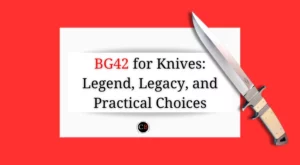What is X50CrMoV15 steel? X50CrMoV15 steel is synonymous with kitchen knives. If you want to buy a new kitchen or chef’s knife today, chances are good that it will be a knife from a popular brand with a blade made of X50CrMoV15 steel.
However, those who have no experience with this steel or generally have little idea about knife steels and their very specific properties may wonder whether or not this steel is suitable for their purposes. Typical questions are about its cutting performance? Whether it is susceptible to rust or not, how easy or difficult it is to sharpen and how well it holds this sharpness, and much more.
In this article, I have gathered all the important information about this knife steel to answer all the questions and ultimately help you decide whether you should buy a knife made of X50CrMoV15 steel or not.
Table of Contents

What is X50CrMoV15 steel?
DIN X50CrMoV15 is a German steel that is especially popular for kitchen knives. Its high rust and corrosion resistance and excellent cutting properties are some of the key features that make this steel ideal for making highly reliable kitchen knife blades.
X50CrMoV15 is a stainless steel and is also known as AISI 420MoV and 1.4116 among others. The cryptic designation X50CrMoV15 stands for 0.5% carbon and the 15% stands for chromium (Cr). The MoV stands for molybdenum (Mo) and vanadium (V) – additional elements that improve the grain structure and durability of the steel. Despite some misleading marketing claims, X50CrMoV15 is NOT a high carbon steel.
Chemical composition of X50CrMoV15 steel
| Element | Portion | Effect |
| Chrome | 15% | Improves wear resistance, heat resistance and scale resistance. It increases tensile strength because it acts as a carbide former. Use of rust-free or stainless steel, as it increases corrosion resistance from a mass proportion of 12.2%. Reduction in weldability. |
| Carbon | 0.5% | Increasing hardness and tensile strength. In larger quantities, increase in brittleness and reduction in forgeability and weldability. |
| Manganese | 1.0% | Improves hardness and tensile strength. |
| Molybdenum | 0.8% | Improves hardenability, tensile strength and weldability. Reduction in forgeability and ductility. |
| Phosphorus | 0.04% | Increases tensile strength, hardness and corrosion resistance but also brittleness. |
| Sulfur | 0.015% | Increases machinability but also brittleness. |
| Silicon | 1.0% | Improves strength. |
| Vanadium | 0.2% | Increasing hardness, increasing wear resistance and improving tempering resistance. |
The mixture of high chromium and low molybdenum content provides higher corrosion resistance than ordinary martensitic steel variants. Likewise, the mixture of molybdenum and vanadium helps to strengthen the grain structure and increase durability.
80CrV2 Steel
Related: Is 80CrV2 steel good for knives?
What is the hardness (HRC) of X50CrMoV15 steel?
X50CrMoV15 can reach a maximum hardness of 56 HRC. However, depending on the manufacturer’s heat treatment, the hardness can range from 52 to 56 HRC. 56 HRC This is a good hardness level – not too soft that a knife would dull quickly and not too hard and thus easy to sharpen.
Is X50CrMoV15 stainless steel?
X50CrMoV15 is a stainless steel but not high-grade steel. To be considered stainless, it must have a chromium content of at least 10.5 – 13% dissolved in the austenite or ferrite, depending on the definition (see here). With 15%, X50CrMoV15 is well equipped here. Unfortunately, this steel is not a stainless steel, since its sulfur and phosphorus content (so-called iron companion), at least in the case of phosphorus with 0.4%, clearly exceeds the limit value (see here).

Properties of X50CrMoV15 steel
According to the chemical composition and the hardness of 56 HRC, this:
1. Edge retention
Due to its low carbon content and relatively low vanadium content, X50CrMoV15 steel cannot produce extremely hard carbides. This means that it is not able to maintain its sharpness for a really long time. Its edge retention is not the worst, but it is at the lower end of the scale of high-end steels. Many users agree that the edge retention is worst when the knife is exposed to abrasive (grinding) cuts. Otherwise, the blade has good stability.
2. Corrosion resistance
The overall high corrosion and rust resistance is one of the reasons why this steel has become the quasi-standard for many kitchen knives. It contains about 15% chromium, which is more than is required to qualify as a “stainless steel.” Along with the addition of molybdenum, this helps prevent the knife from rusting or staining in wet or humid environments.
3. Wear resistance
The hardness level of X50CrMoV15 is enough to make the blade last for years by keeping wear away, even if the knife is used frequently.
4. Sharpness
Another plus point of X50CrMoV15 is that it is extremely easy to sharpen. This is because it has a moderate carbon content, which makes it less hard. For those who are just learning to sharpen knives, this steel is good practice material because you can get a razor sharp edge in almost no time.
5. Toughness
One of the qualities that have made this knife steel so well known is the high toughness it offers – it compensates for not being a super hard steel. It’s impressive how well an X50CrMoV15 knife can withstand impacts, blows, and lateral forces when it’s abused or facing tough cutting tasks.
Is X50CrMoV15 a good knife steel?
X50CrMoV15 is a good steel for knives and offers high toughness, easy sharpening and good corrosion resistance. The ability to withstand abuse and resist corrosion makes this steel ideal for kitchen or camping / bushcraft knives.
The ease of sharpening makes the X50CrMoV15 stainless steel suitable for beginners who have yet to learn how to sharpen. What speaks against the suitability for an outdoor knife is that this steel does not keep its sharpness for long – you have to sharpen it practically before each use.
This is tolerable for kitchen knives – we can see the pictures where chefs or butchers sharpen their knives with a sharpening steel before use – but on the other hand this makes this steel not very interesting for an outdoor knife. And that is probably the reason why it is practically not found in outdoor knives.
The fair price of knives made of this steel nevertheless makes them a good choice for knife users on a budget who are looking for a quality knife with great performance, but you shouldn’t be afraid of having to sharpen it regularly.

X50CrMoV15 vs. other steel
1. X50CrMoV15 vs. AUS10 steel
The edge retention of AUS10 is superior to that of X50CrMoV15, or in other words, AUs10 stays sharp longer. Both steels have high corrosion resistance, but X50CrMoV15 is easier to sharpen harder than AUS-10.
2. X50CrMoV15 vs. VG10 steel
VG10 is a high carbon steel and offers impressive edge retention. However, it is more difficult to sharpen and less tough than X50CrMoV15 steel. However, both steels have high corrosion resistance.
3. X50CrMoV15 vs 440C steel
A 440C cutting edge holds its sharpness better and offers higher corrosion resistance compared to X50CrMoV15, but its toughness is lower.
Conclusion: What is X50CrMoV15 steel
There is a reason why X50CrMoV15 steel is not found in outdoor knives – and that is its ability to hold a sharp edge (not for long). Although theoretically its toughness is in its favor, the need for sharpening before use is not a desirable characteristic, and here there are knives in the same price range that have better properties.
However, if you are looking for a reliable kitchen knife at a reasonable price and are not afraid of prior honing on a sharpening steel or similar (a standard practice in the kitchen anyway), you should also consider models made of X50CrMoV15.
The German-made steel is characterized by excellent corrosion resistance, hardness and toughness. Its only drawback, as mentioned, is poor edge retention, so it requires regular sharpening. However, this is compensated by the fact that this steel is very easy to sharpen.



